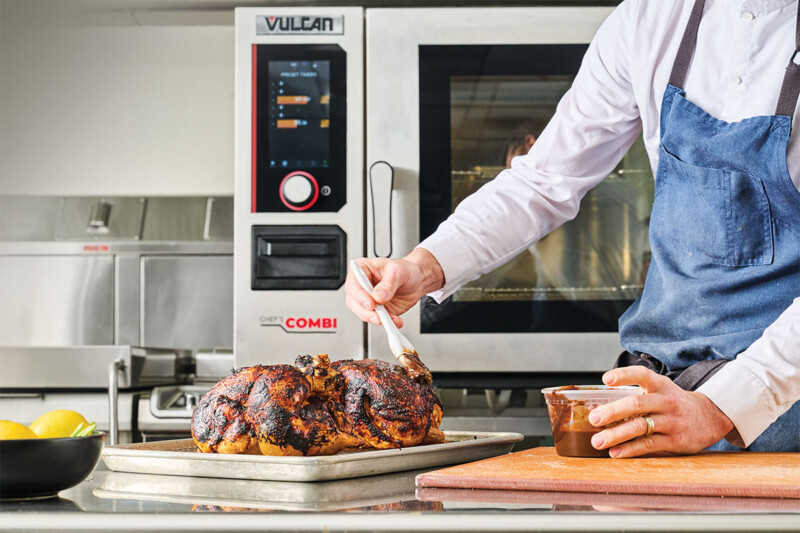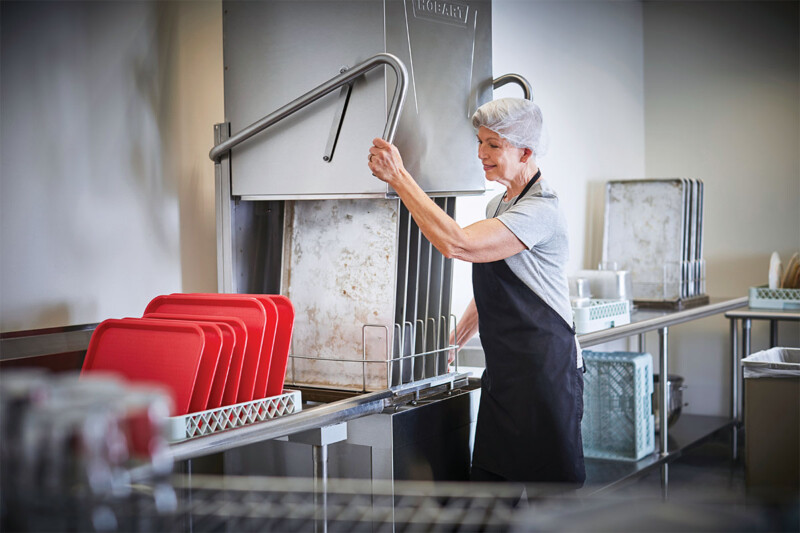Immersion blenders, also called stick blenders, could be one of the most versatile tools you can buy for your kitchen. With a powerful motor on one end and either a cutting blade or mixing accessory on the other, immersion blenders mix, chop, grate, blend, puree, emulsify, whip and more.
Perhaps the biggest advantage to immersion blenders is their portability. They’re almost like having a food processor on the end of a stick that you can take where they’re needed, as opposed to bringing the food to the appliance. The benefits include convenience, saving time and reducing the number of containers and/or appliances to wash.
Because they come in a range of sizes, chefs can use them to emulsify a sauce in a 3-qt. saucepan or blend soup ingredients in a 75-qt. stockpot. To give you an idea of their versatility, some other applications include:
• Mixing salsa ingredients in a 5-gal. bucket to go directly into the walk-in for storage.
• Blending pancake batter in a bowl or bucket for use at the griddle.
• Pureeing vegetables in a stockpot to make soup.
• Emulsifying aioli in a bowl or storage container.
• Mashing potatoes in the pot they cooked for service or transfer to hotel pans.
• Blending salad dressings in storage containers.
Accessories available from many makers just add to the list of tasks your staff can accomplish with one tool. Beaters, which resemble “egg beaters” of old, allow you to mix batters for baked goods, mousses or soufflés. Wire whips let you whip cream or aerate sauces and dessert mixes. One manufacturer offers a ricer attachment to rice potatoes.
Basics And Beyond
Stick blenders have three basic components: motor, shaft and blade. All of the components work in concert to do the best possible job for any given application.
Although some manufacturers now rate the power level of their models in horsepower (usually associated with motors), most still rate in watts (mostly associated with electrical loads, but 1 hp equals 745W). Motors range from about 200W up to 1,000W. The more powerful the mixer, obviously, the larger the quantity and density of product it can mix.
Typically, manufacturers will offer a range of shaft lengths. Shafts may be as short as 8 in. or as long as 29 in. The most popular sizes are in the 16-18-in. range. Power increases as shafts lengthen—the assumption is you need a longer shaft for a bigger stockpot and more power to stir or blend its contents.
Mixing-blade shafts, also called cutter tubes, may or may not be detachable. Detachable models usually are designed to make it easy to clean the blades apart from the motor and accommodate assorted accessories, such as beaters and wire whips. Be cautious if a manufacturer suggests that you can attach mixing-blade shafts of varying lengths onto one motor unit. Mixing-blade shafts are designed to pair shaft length with the right motor size to achieve a specific mixing strength and torque. Too long a shaft on too small a motor, and you can burn out the motor. Too large a motor paired with too small a shaft is overkill.
Shafts are made of stainless, but detachable shafts may have a plastic housing over where they connect to the motor. Detachable shafts should be cleaned manually by immersing them in warm water with a mild detergent and rinsing in hot water or a sanitizing solution. Dishmachines may be too harsh for plastic parts.
On most models, the bell housing that shields the blade at the end of the shaft is permanently fastened, but at least one manufacturer makes a detachable bell housing so the unit can be cleaned even more easily.
On some stick-blender models, the blade is S-shaped, much like that of a food processor. Others use a three-pronged blade similar to that on a blender. Both do a good job of mixing, chopping, blending, etc., so it comes down to personal preference and what works best in your application.
Blades should be kept sharp, which means removing and sharpening or replacing them, depending on what’s possible with the model you choose. Ask up front about how to keep blades sharp, and either sharpen or replace blades at least once a year.
You’re In Control
While these units are technically hand blenders, the bigger the sticks the more difficult they may be to handle, at least with one hand. Units weigh from a few pounds up to about 15 lb. for the largest units. Ergonomics are important, and while all manufacturers claim to design their models with an easy grip and effortless use, think of who on your staff will use them most often.
Some models have a looped handle to make them less likely to slip out of a user’s grasp. Others use a pommel at the top of the grip to keep the blender from sliding out of a user’s hand. Some larger models even have handles on both sides for two-handed use.
Most manufacturers offer some sort of pan rest or kettle mount that users can clip on to a pan or pot. The blender then rests in the clip so users aren’t bearing all of the unit’s weight. One maker says a lug on the bottom of the motor unit on its larger models can catch the lip of a pot or pan and serve as a rest and pivot for the unit.
Most units run at pretty high speeds, typically anywhere from about 8,500-12,000 rpm. One manufacturer even claims its unit runs at 18,000 rpm. Many models simply have an on-off switch and run at a single speed. Some manufacturers make two-speed models, and several offer variable-speed models either standard or as an option.
Variable speeds come in handy when you add attachments like beaters or a wire whip, giving you more control over mixing batters and whipping cream or egg whites for meringue. Two-speed models may not offer high enough rpm for the job at hand, so consider your applications and spend the money for variable speeds if you need them.
Some models provide a little more control, adding a continuous-run switch to a start-stop switch. And some larger units feature a safety switch, which requires users to hold the blender with both hands for operation: one to push the start/stop button, the other to push the run button. Variable-speed models, of course, have a knob to dial the speed up or down.
Immersion blenders are air-cooled, but in a hot kitchen at high rpm, motors can get taxed, especially on tough jobs. Most makers recommend limiting continuous use to about six or seven minutes, then letting the motor cool before starting another cycle. Better models have a limit switch to prevent overheating, and at least one maker’s models have a warning light that goes on when the units start to get too hot.
Another part likely to wear faster than the rest of the unit is the electric cord. Several models are designed with cord storage in mind, and at least one manufacturer makes its cords detachable so cords can be stored separately or unplugged from the unit for cleaning or servicing.
With a little care, stick blenders will last about seven years. Check out the sidebar of leading immersion blender manufacturers above.
Immersion Blender Makers
BakeMax
Dynamic Mixers USA
Electrolux Professional (Berimixer)
Hamilton Beach Commercial
KitchenAid Commercial
Robot Coupe USA
Sammic
Sirman USA
Thunderbird Food Machinery
Victorinox/Forschner (Bamix)
Waring Commercial
RELATED CONTENT
- Advertisement -
- Advertisement -
- Advertisement -
TRENDING NOW
- Advertisement -
- Advertisement -
- Advertisement -


